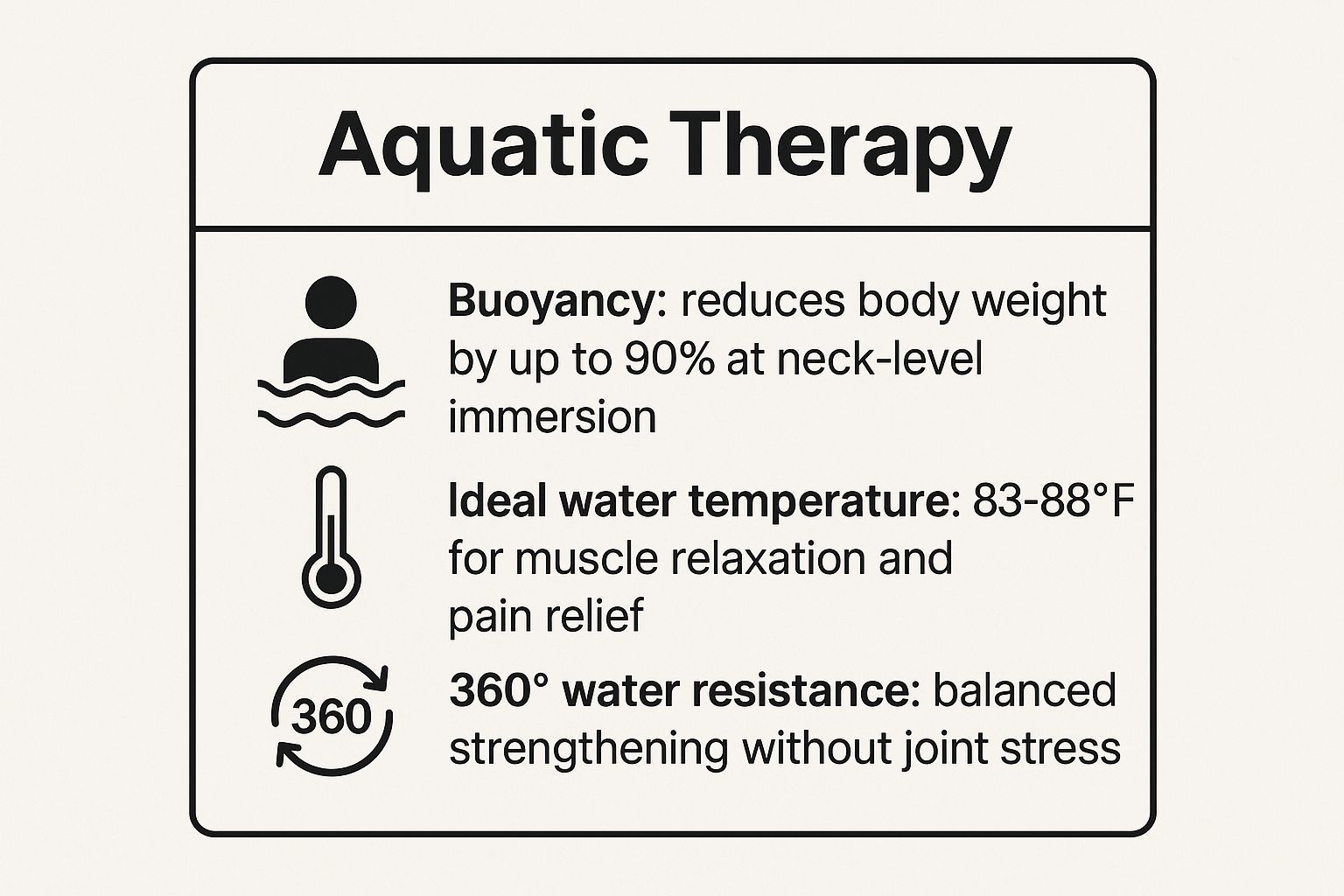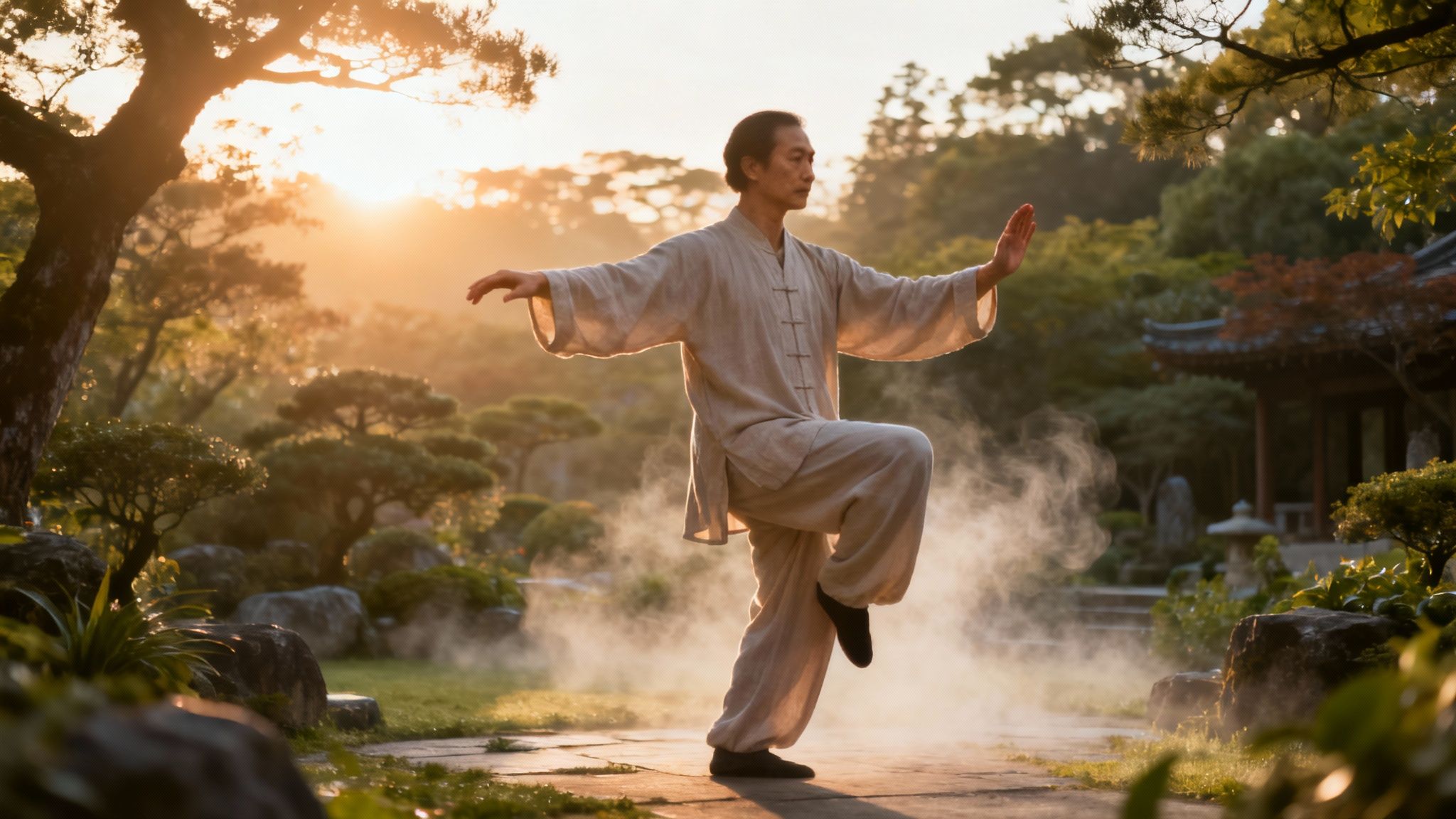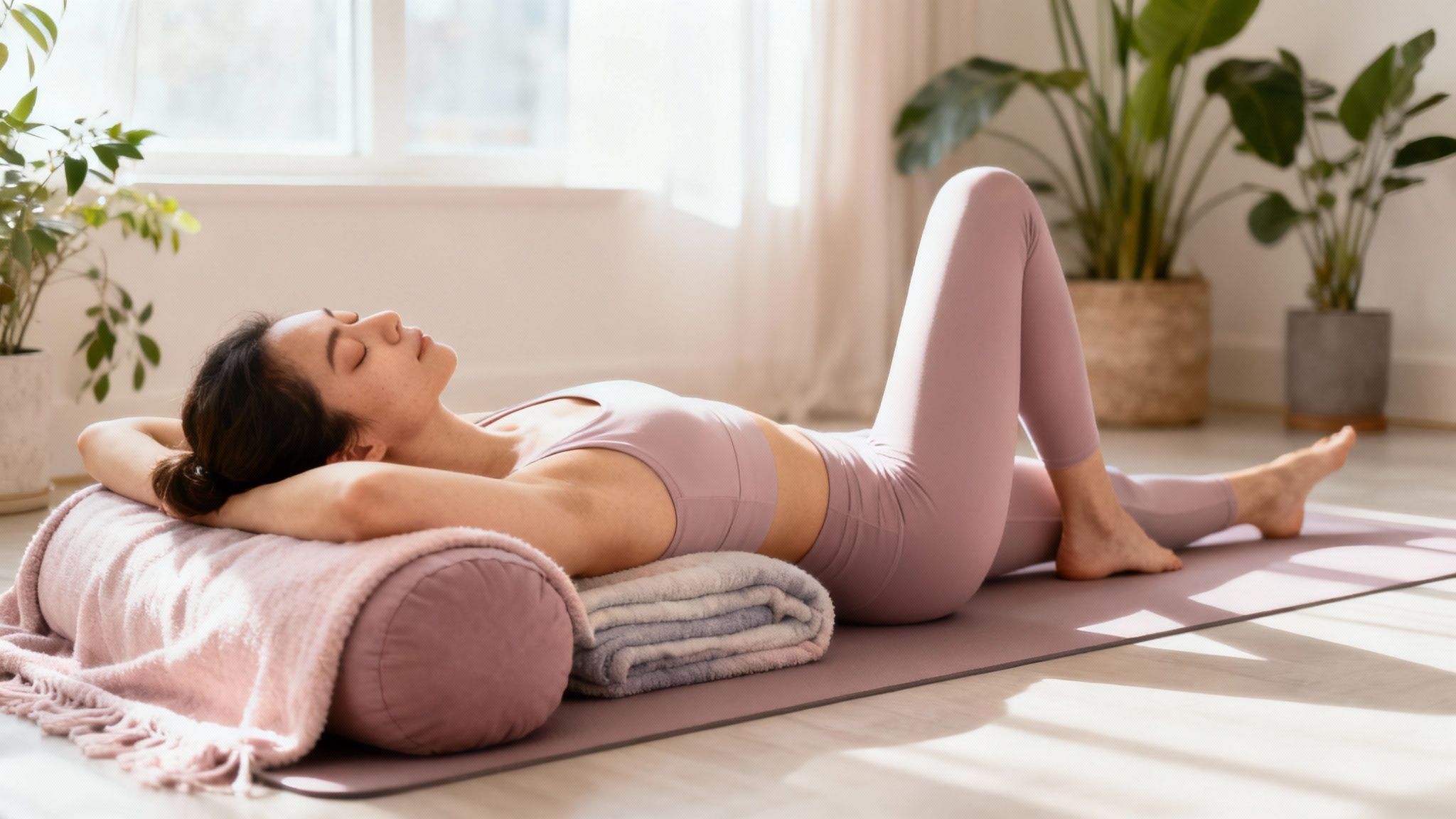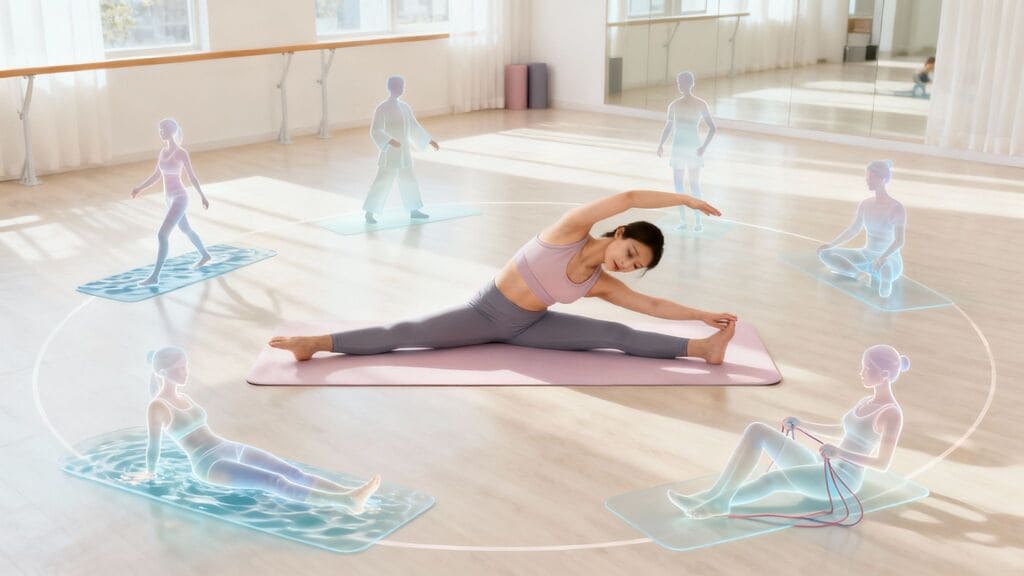Living with fibromyalgia can feel like a constant battle between the need to stay active and the fear of triggering pain. The old advice of 'no pain, no gain' simply doesn't apply. Instead, a gentle, intelligent approach to movement is essential for managing symptoms, improving energy, and reclaiming your quality of life. The key isn't to push through the pain, but to find activities that soothe, strengthen, and support your body's unique needs. This guide is organised to help you do just that.
We will explore the seven best exercises for fibromyalgia, each selected for its proven benefits in reducing pain and fatigue while improving flexibility and mood. We will move beyond a simple list, offering actionable advice on how to start safely, listen to your body, and adapt movements to your specific energy levels on any given day.
Forget the pressure of intense workouts. This article focuses on a compassionate and sustainable path to better well-being. We'll provide the practical details you need to integrate these healing movements into your daily routine, helping you build strength and confidence. From the supportive environment of aquatic therapy to the mindful flow of Tai Chi, you will discover effective ways to manage your condition and feel better in your body.
1. Aquatic Therapy (Water Aerobics)
Aquatic therapy, often called water aerobics, is consistently ranked among the best exercises for fibromyalgia due to its unique, gentle approach to movement. This form of exercise takes place in a heated pool, typically maintained between 28-31°C. The warm water soothes aching muscles and improves circulation, while the water's natural buoyancy provides a low-impact environment that supports your body and reduces stress on painful joints and tender points.
The magic of aquatic therapy lies in the properties of water itself. It offers 360-degree resistance, which helps to strengthen muscles evenly without the jarring impact associated with land-based exercises. This allows individuals with fibromyalgia to build stamina and strength, which can often feel impossible during a flare-up. Leading organisations, including the Arthritis Foundation and the American College of Rheumatology, recommend it as a foundational part of a fibromyalgia management plan. Many NHS trusts and local community centres, like the YMCA, offer specialised warm-water classes designed for chronic pain conditions.
Why It Works for Fibromyalgia
Aquatic therapy directly counters several core fibromyalgia symptoms. The buoyancy offloads weight from your joints, making movement less painful and more fluid. The gentle hydrostatic pressure of the water can also help reduce swelling and improve awareness of your body's position, known as proprioception. This combination of support, resistance, and warmth makes it an ideal starting point for those who find other forms of exercise too painful or exhausting.
For a quick reference on why water is so effective, this summary highlights the key benefits of aquatic exercise for fibromyalgia management.

These data points illustrate how the unique physical properties of water create a therapeutic environment that reduces joint load while simultaneously building balanced muscle strength.
How to Get Started
- Start Slowly: Begin with short sessions of 10-15 minutes, two to three times per week. Focus on simple movements like walking from one side of the pool to the other.
- Gradual Progression: As your body adapts, slowly increase your session duration to 30-45 minutes. You can then incorporate more structured movements like leg lifts or gentle arm exercises.
- Use Flotation Aids: Don't hesitate to use a pool noodle or flotation belt for extra support and stability, especially when you are just starting out.
- Listen to Your Body: Avoid exercising during periods of intense fatigue or pain. The goal is gentle movement, not pushing through discomfort.
- Stay Hydrated: It's easy to forget to drink water when you're in a pool, but you are still exerting yourself and sweating. Keep a water bottle at the pool's edge.
By integrating this gentle yet effective exercise, you can improve mobility, reduce pain, and regain a sense of control over your body. For those exploring comprehensive wellness strategies, it's also worth noting how complementary approaches can support an active lifestyle. You can find more information about natural relief strategies for inflammation that can work alongside a consistent exercise routine.
2. Tai Chi
Tai Chi is a traditional Chinese mind-body practice that combines slow, graceful movements with deep breathing and mental focus. Often called "meditation in motion," it is a low-impact exercise that is exceptionally well-suited for fibromyalgia, as it enhances balance, flexibility, and physical conditioning without straining the body. Its gentle, flowing nature makes it one of the best exercises for fibromyalgia, promoting both physical strength and mental calm.

The effectiveness of Tai Chi for fibromyalgia is supported by robust scientific evidence. A landmark 2018 study published in the BMJ found that Tai Chi was more effective than aerobic exercise at improving fibromyalgia symptoms. Research from Tufts Medical Center in the US has also consistently shown significant reductions in pain and improvements in sleep and quality of life for participants. Consequently, leading institutions like Kaiser Permanente now offer dedicated Tai Chi classes for managing chronic pain.
Why It Works for Fibromyalgia
Tai Chi directly addresses the nervous system's hypersensitivity, a core issue in fibromyalgia. The slow, deliberate movements help recalibrate the body's pain response, while the meditative focus reduces the "fight or flight" stress reaction that often exacerbates symptoms. This practice improves proprioception (your sense of body position), reduces stiffness, and enhances functional mobility, making everyday activities less challenging. The integration of movement and mindfulness helps break the cycle of pain, fatigue, and anxiety.
This video provides an excellent introduction to Tai Chi movements suitable for beginners dealing with chronic pain.
The gentle, mindful approach can be a powerful tool for managing not just physical pain but also the mental and emotional strain that comes with fibromyalgia.
How to Get Started
- Choose the Right Style: Start with the Yang style, which is the most widely practised and features gentle, slow movements ideal for beginners.
- Find an Experienced Instructor: Look for a teacher who has experience adapting movements for people with chronic pain conditions.
- Start Small: Begin with short 10-20 minute sessions two to three times per week, gradually building up to 60 minutes as your stamina improves.
- Focus on Breath, Not Perfection: Initially, concentrate on your breathing and the feeling of movement rather than achieving perfect form.
- Listen to Your Body: During a flare-up, adapt standing poses to a seated version. Never push through sharp pain.
- Be Patient: While some benefits may be felt quickly, significant improvements often become noticeable after 8-12 weeks of consistent practice.
By incorporating Tai Chi, you engage in a practice that nurtures both body and mind. This holistic approach is crucial, as managing conditions like fibromyalgia often involves addressing related issues such as anxiety. For those interested, you can learn more about natural relief for anxiety which complements a mind-body exercise routine.
3. Yoga (Gentle and Restorative)
Gentle and restorative yoga are frequently recommended as some of the best exercises for fibromyalgia because they merge slow, mindful movement with essential relaxation techniques. Unlike more athletic yoga styles, this approach prioritises comfort and body awareness over achieving perfect postures. It combines physical poses (asanas), controlled breathing (pranayama), and meditation to help manage both the widespread physical pain and the emotional stress that often accompany the condition.
The practice focuses on calming the central nervous system, which is often overactive in people with fibromyalgia. This mindful approach has been validated by research, such as studies from Oregon Health & Science University showing that specialised yoga programmes can significantly reduce fibromyalgia symptoms and improve coping abilities. Similarly, the Johns Hopkins Arthritis Centre often includes gentle yoga in its comprehensive treatment plans, recognising its dual benefit for mind and body.

Why It Works for Fibromyalgia
Gentle yoga directly addresses the 'wind-up' phenomenon of the nervous system seen in fibromyalgia, helping to reduce pain signals and promote a state of relaxation. The slow, deliberate stretches can ease muscle stiffness and improve flexibility without causing post-exertional malaise. Furthermore, the focus on breathwork and mindfulness provides powerful tools for managing the anxiety and 'fibro fog' that are common symptoms, improving overall mental clarity and emotional resilience.
How to Get Started
- Choose the Right Style: Look for classes specifically labelled as 'Restorative', 'Gentle', 'Hatha', or 'Chair Yoga'. Avoid styles like Power, Vinyasa, or Bikram, which can be too intense.
- Communicate with Your Instructor: Before class begins, let the teacher know you have fibromyalgia so they can offer appropriate modifications.
- Embrace Props: Use props like blocks, blankets, and bolsters to support your body. This allows you to relax into poses without straining your muscles or joints.
- Practice Non-Harming (Ahimsa): This is a core principle of yoga. Never push into sharp pain. If a pose hurts, gently back out of it.
- Listen to Your Energy Levels: Practice during the time of day when you typically have the most energy. Start with short sessions of 15-20 minutes and build up gradually.
4. Walking (Paced and Progressive)
Walking is frequently heralded as a foundational exercise for fibromyalgia management due to its remarkable accessibility and low cost. The real key to making it effective, however, is the "paced and progressive" approach. This strategy involves starting with very short, manageable walks and gradually increasing the duration over time, a method designed specifically to prevent the post-exertional symptom flare-ups that often deter people with fibromyalgia from exercising.
This carefully structured approach helps to build cardiovascular fitness, improve mood, and reduce pain sensitivity without overwhelming the body. Its effectiveness is recognised by leading medical bodies; for instance, the American College of Rheumatology includes it in its official treatment guidelines, and the UK National Health Service often recommends walking as a first-line exercise. Studies evaluating programmes like the Cleveland Clinic's 12-week progressive walking plan have shown significant reductions in pain and improvements in overall function for participants.
Why It Works for Fibromyalgia
Paced walking directly addresses the core challenge of exercising with fibromyalgia: avoiding the boom-and-bust cycle. By starting small, often with just 5-10 minutes, you allow your nervous system to adapt to movement without triggering a widespread pain response. This gradual increase in activity helps to recalibrate the body's pain processing systems, improve sleep quality, and boost energy levels over the long term. It empowers you to build physical resilience safely and sustainably, making it one of the best exercises for fibromyalgia.
How to Get Started
- Start Extremely Small: If you are currently inactive, begin with a 5-minute walk on a flat surface. Your initial goal is consistency, not distance or speed.
- Follow the 10% Rule: Increase your walking time by no more than 10% each week. For example, progress from a 10-minute walk to an 11-minute walk the following week.
- Use the '2-Hour Rule': Pay close attention to how you feel in the two hours following your walk. If your pain or fatigue has significantly increased, reduce the duration of your next walk.
- Focus on a Conversational Pace: You should be able to hold a conversation comfortably while walking. If you are breathless, you are pushing too hard.
- Invest in Proper Footwear: Cushioned walking shoes with good arch support are essential to minimise stress on your joints in the feet, knees, and hips.
- Consider Walking Poles: Nordic walking poles can help distribute the effort across your upper body, reducing the load on your legs and improving your posture.
By adopting a paced approach, walking becomes a powerful therapeutic tool rather than a source of pain. For those seeking complementary methods to manage symptoms alongside exercise, further insight into how CBD oil may help with fibromyalgia can offer additional support for your wellness journey.
5. Pilates (Modified)
Modified Pilates is a highly effective, low-impact exercise that has been adapted to meet the specific needs of individuals with chronic pain conditions like fibromyalgia. It focuses on strengthening the deep core muscles, improving postural alignment, and enhancing body awareness through slow, controlled movements. Unlike traditional Pilates, which can be vigorous, the modified version prioritises precision and breath control over intensity, ensuring it doesn't overtax sensitive muscles or trigger flare-ups.
The brilliance of modified Pilates is its emphasis on rebuilding the mind-body connection, which can be disrupted by chronic pain. By concentrating on controlled breathing and precise muscle engagement, it helps to re-educate the body’s movement patterns and reduce strain on painful areas. Many physical therapy clinics and specialised studios, like those offering Stott Pilates for rehabilitation, incorporate these gentle methods. This approach is recognised as one of the best exercises for fibromyalgia because it builds foundational strength that supports the body, potentially reducing widespread pain over time.
Why It Works for Fibromyalgia
Modified Pilates directly addresses the secondary pain that often arises from poor posture and muscle guarding, which are common responses to fibromyalgia pain. By strengthening the core, it creates a stable "girdle of strength" around the torso, which offloads pressure from the back, hips, and shoulders. This enhanced stability and improved body awareness can lead to more efficient, less painful movement in daily life, helping to break the cycle of pain and inactivity.
This focus on core stability and mindful movement helps to reduce compensatory patterns that exacerbate fibromyalgia symptoms. It builds strength without causing the micro-trauma associated with high-impact exercises, making it a safe and sustainable practice.
How to Get Started
- Find a Qualified Instructor: Seek out an instructor certified in rehabilitation or clinical Pilates who has experience working with clients with chronic pain.
- Start with Mat Work: Begin with mat-based exercises, as they use your own body weight for resistance and are easier to modify.
- Prioritise Quality over Quantity: Focus on performing a few repetitions with perfect form and deep, controlled breathing rather than trying to do many reps.
- Use Props for Support: Use cushions, small balls, and resistance bands to support your body and make exercises more accessible and comfortable.
- Communicate Openly: Inform your instructor about your pain levels before each session so they can adapt the exercises accordingly. Never push through sharp or increasing pain.
- Be Patient: Start with short sessions of 15-20 minutes, twice a week, and gradually increase the duration as your strength and stamina improve.
6. Resistance Training (Low-Intensity)
Low-intensity resistance training is a powerful yet often overlooked exercise for managing fibromyalgia. This approach involves using light weights, resistance bands, or your own body weight to build muscle strength gradually, avoiding the excessive fatigue or pain flares that can be triggered by more intense workouts. For individuals with fibromyalgia, maintaining muscle mass is crucial, as weakness can lead to a cycle of increased pain, poor posture, and functional decline.
The effectiveness of this method is supported by significant research. A notable Swedish study, led by researcher Dr Kaisa Mannerkorpi, demonstrated that 15 weeks of progressive, low-intensity resistance training significantly reduced pain and improved muscle strength in women with fibromyalgia. The American College of Sports Medicine also provides guidelines recommending this form of exercise. The goal is not to become a bodybuilder but to strengthen the muscles that support your joints, making everyday activities less taxing and painful.
Why It Works for Fibromyalgia
Resistance training directly addresses the deconditioning and muscle weakness common in fibromyalgia. Stronger muscles provide better support for your joints, which can decrease strain and reduce pain. This type of exercise also stimulates the release of endorphins, the body's natural painkillers, and can improve sleep quality and mood. By starting with very low intensity and progressing slowly, it allows the body to adapt without triggering the "post-exertional malaise" that many people with fibromyalgia fear.
The key is consistency and gradual progression. Building a stronger functional base helps you break the cycle of pain and inactivity, improving your overall quality of life and sense of physical capability.
How to Get Started
- Start with Minimal Resistance: Begin with just your body weight, light resistance bands, or weights as light as 1-2 lbs (around 0.5-1 kg). Focus on mastering the form first.
- Focus on Major Muscle Groups: Incorporate 6-8 functional exercises that target the whole body, such as chair squats, wall push-ups, and seated rows with a band.
- Keep Reps and Sets Low: Start with just one set of 5-10 repetitions for each exercise. Your initial goal is to build a routine without overexertion.
- Train Twice a Week: Schedule your sessions on non-consecutive days, allowing at least 48 hours for your muscles to recover and adapt.
- Listen to Your Body: Use the "two-hour rule." If your pain or fatigue is significantly worse more than two hours after exercising, you have done too much. Reduce the intensity or duration next time.
- Progress Slowly: Increase the number of repetitions before you consider increasing the weight. For example, work up to 12-15 reps before moving to the next level of resistance band or a heavier weight.
Integrating a gentle strength routine can be a game-changer for long-term fibromyalgia management. For those interested in a holistic approach to physical wellness, understanding how to support muscle recovery is also vital. You can discover more about natural recovery strategies for athletes that can complement your new exercise regimen.
7. Qigong
Qigong (pronounced 'chee-gong') is an ancient Chinese mind-body practice that harmonises slow, gentle movements with controlled breathing and meditation. It is often described as being similar to Tai Chi, but its forms are typically simpler and more repetitive, making it one of the best exercises for fibromyalgia, especially for those who find complex sequences difficult. The core principle is to cultivate and balance the body's vital energy, or 'qi', to promote healing and well-being.
This practice is highly regarded for its accessibility and profound therapeutic effects. Its slow, deliberate nature helps to calm the nervous system, a key benefit for a condition often characterised by central sensitisation. Research supports its effectiveness; a study in Evidence-Based Complementary and Alternative Medicine found that just six weeks of Qigong significantly reduced pain and improved sleep quality in fibromyalgia patients. Many integrative health centres now incorporate Qigong into their fibromyalgia management protocols, recognising its dual physical and mental health benefits.
Why It Works for Fibromyalgia
Qigong directly addresses the interconnected symptoms of fibromyalgia by integrating gentle physical activity with mental relaxation. The flowing movements improve flexibility, reduce stiffness, and enhance circulation without straining painful muscles or joints. Simultaneously, the focus on deep, diaphragmatic breathing helps to switch the body from a 'fight-or-flight' state to a 'rest-and-digest' state, which can lower stress, reduce anxiety, and improve pain perception. This mind-body synergy makes it a powerful tool for managing chronic pain and fatigue.
How to Get Started
- Start Simple and Seated: Begin with seated or very basic standing forms to build confidence and avoid overexertion. Beginner-friendly forms like the "Eight Brocades" or "Six Healing Sounds" are excellent starting points.
- Keep Sessions Short: Practice for just 10-15 minutes daily. This consistency is more important than duration. As you feel able, you can gradually increase your sessions to 30-45 minutes.
- Establish a Routine: Try to practice at the same time each day. A morning session can help ease stiffness and set a calm tone for the day, while an evening practice can promote better sleep.
- Focus on Breath, Not Perfection: The primary goal is relaxation and mindful breathing. Don't worry about executing the movements perfectly; concentrate on how your body feels.
- Use Guided Resources: There are numerous high-quality online videos, apps, and DVDs that provide guided instruction, making it easy to start at home.
- Listen to Your Body: Qigong should feel restorative, not strenuous. Never force a movement or push through sharp pain. Adapt the exercises to your comfort level on any given day.
7 Best Exercises for Fibromyalgia Compared
| Item | Implementation Complexity 🔄 | Resource Requirements ⚡ | Expected Outcomes ⭐📊 | Ideal Use Cases 💡 | Key Advantages ⭐ |
|---|---|---|---|---|---|
| Aquatic Therapy (Water Aerobics) | Moderate (pool access, facility needed) | High (heated pool, membership fees) | Pain relief, improved ROM, low joint stress, gradual cardio | Fibromyalgia patients needing low-impact exercise | Joint/muscle stress reduction, warm water pain relief, balanced resistance |
| Tai Chi | Moderate to High (learning sequences) | Low (no equipment, instructor recommended) | Reduced pain and fatigue, better balance, sleep improvement | Those wanting mind-body exercise with mental focus | Low injury risk, stress reduction, improves balance, sustainable long-term |
| Yoga (Gentle and Restorative) | Moderate (requires fibromyalgia-aware instruction) | Low (props and space; can practice at home) | Improved flexibility, reduced stress, better sleep | Those needing gentle stretching and relaxation | Mindfulness integration, customizable, accessible with props |
| Walking (Paced and Progressive) | Low (easy to start, pacing required) | Very Low (comfortable shoes, accessible routes) | Cardiovascular improvements, mood enhancement, functional gains | Beginners needing free, adaptable exercise | Accessible, low cost, improves cardio and mood, flexible timing |
| Pilates (Modified) | Moderate to High (qualified instructor needed) | Moderate (studio or mat, possible equipment) | Core strength, posture correction, pain management | Those focused on core stability and alignment | Low-impact, improved posture, mind-body awareness |
| Resistance Training (Low-Intensity) | Moderate (instruction needed for form) | Low to Moderate (bands, light weights at home possible) | Muscle strength, functional capacity, bone density | Patients needing strength without flare risk | Prevents muscle atrophy, improves metabolic health, home-friendly |
| Qigong | Low to Moderate (simple movements, regular practice) | Very Low (no equipment, minimal space) | Pain reduction, improved sleep, energy boost | Those wanting simple, meditative movement practices | Easy to learn, adaptable, deep relaxation, suitable for severe limitations |
Your Path Forward: Creating a Sustainable Exercise Routine
Embarking on a new exercise plan with fibromyalgia can feel like a monumental task, but the journey you have explored through this guide is one of empowerment. We have delved into a variety of gentle, low-impact activities, from the supportive buoyancy of aquatic therapy and the mindful flow of Tai Chi to the restorative poses of yoga. Each option, including paced walking, modified Pilates, and light resistance training, offers a unique pathway to increased strength, improved flexibility, and reduced pain.
The central theme connecting all these effective approaches is the principle of listening to your body. This is not just advice; it is the cornerstone of a successful and sustainable fitness journey with fibromyalgia. The goal is not to push through pain but to work with your body's current capabilities, celebrating small, consistent efforts over infrequent, intense exertion.
Crafting Your Personalised Plan
The true 'best exercise for fibromyalgia' is not a single activity but a personalised, adaptable routine that brings you joy and relief. The key to long-term success lies in creating a plan that fits your life and respects your body’s fluctuating energy levels and pain signals.
- Start Small and Slow: Begin with just 5-10 minutes of movement on your good days. This could be a short walk to the end of the street or a few simple yoga stretches. The aim is to build momentum without triggering a flare-up.
- Create a Diverse Toolkit: You are not limited to one type of exercise. Consider building a weekly plan that incorporates variety. For example, you might enjoy two sessions of water aerobics, two short walks, and one restorative yoga session. This variety keeps things interesting and works different muscle groups gently.
- The "Spoon Theory" in Action: Be mindful of your energy expenditure. On a low-energy day (a "few spoons" day), a few minutes of gentle Qigong or seated stretches might be all you can manage, and that is a significant victory. On higher-energy days, you might attempt a longer walk or a modified Pilates class.
- Track Your Progress and Feelings: Keep a simple journal to note how different activities affect your pain, energy, and mood. This data will become an invaluable tool for understanding your body's patterns and fine-tuning your routine for optimal results.
Ultimately, reclaiming movement is a powerful act of self-care. It is about shifting the focus from limitations to possibilities. By embracing gentle, consistent activity, you are not just managing symptoms; you are actively building a more resilient body, a calmer mind, and a more vibrant life. Remember to consult with your doctor or a qualified physiotherapist to ensure your chosen plan is safe and appropriate for your specific health needs. Your path forward is unique, and with patience and self-compassion, you can successfully navigate it.
Ready to support your active lifestyle and aid your recovery? Many find that high-quality CBD can help soothe exercise-related discomfort and promote a sense of calm. Explore the premium, lab-tested range of CBD oils and topicals at SMOKO CBD to find the perfect complement to your wellness routine. Visit SMOKO CBD to learn more.









